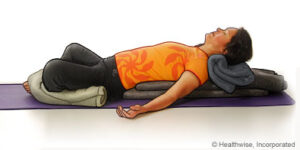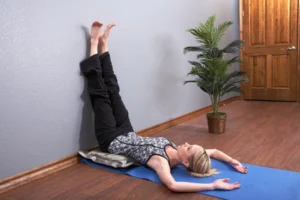Create a self-soothing toolkit
Tools for a self-soothing toolkit
From time to time, we all need a little boost in self-soothing. It’s helpful to have a toolkit – things that we can use to calm our nervous system at any time. These techniques are also good components of a bedtime routine. Here are a few of my favorite tools in my self-soothing toolkit:
Quick Coherence Technique – video here. Breathe from the center of your chest; slow down your respiratory rate to about 5 seconds in, 5 seconds out. Once you have the rhythm, deliberately access good feelings by thinking of someone or something that inspires gratitude, compassion, or appreciation. Do this for 3-5 minutes.
Andrew Weil’s 4-7-8 breathing – video here. Breathe in for a count of 4, hold for a count of 7, exhale for a count of 8. Repeat.
Simple EFT – video here. Tap on the sides of your hands, thinking of your problem and affirming that you accept yourself. Then tap the top of your head, inside eyebrow corner, outside of eye, under eye, under nose, under lip, under collar bone, and under armpits. Repeat till you feel better.
Soothing Butterfly Hug – video here. Cross your hands over your chest and alternate tapping each side, rhythmically, like the wings of a butterfly. Do this for several minutes while breathing comfortably.
Simplified Self-Havening – video here. Place your hands on opposite shoulders and run them down your arms to your elbows, firmly but not harshly. Repeat.
Yoga moves for relaxation – especially great for bedtime.
Use rolled blankets and pillows for support! Hold each pose for a few minutes. For an extra-soothing session, play some soothing background music, like this from Buddha’s Lounge, or this from Zen Meditation Planet.
Child’s Pose
Supported Bridge Pose
Reclining Bound Angle Pose
Corpse Pose/Savasana
Soothing bedtime routine
After washing up and getting into your comfy clothes, light a candle, pull out your notebook, and take a few minutes to reflect on your day. Write your gratitudes – three unique things you are grateful for right now. Keep your lighting as dim as feasible for this.
Then, dim the lights even more. Pull out your yoga mat, some rolled blankets and pillows, turn on some soothing music, and do a few soothing yoga postures.
Sit on your mat, or on some pillows on your mat, close your eyes, and do a few minutes of Quick Coherence Technique or 4-7-8 breathing (see above).
Spray your pillow with lavender. Roll up your mat, put your blankets and pillows back, blow out your candle. Make any final adjustments before going to bed.
Make sure your room is dark and cool, and that your bedding and bedclothes are not too warm.
You can lie on your back with one hand on your heart and one on your belly while you allow a soft smile to play on your face. Think gently about the goodness of your day, the sweet dreams you will have, and allow yourself to drift off to sleep.
If you have trouble sleeping, try entraining your brainwaves by breathing slowly or listening to some delta wave binaural beats, like this from Yellow Brick Cinema or this from Sleep Tube. I really love this from Jason Lewis Mind Amend, though it’s alpha-theta waves and meant to boost the immune system. 😊
What are your favorite bedtime routines? Your favorite items for a self-soothing toolkit? Leave me a comment and let me know!
Image sources: Child's Pose: Very Well Fit; Supported Bridge: Women's Health Network; Reclining Bound Angle: My Health Alberta; Legs Up the Wall: Peleton; Supported Spinal Twist: Yoga International; Savasana: Yoga Journal
Sarah Murphy, LPC, ACP-EFT, is a counselor in private practice and specializes in working with people who have serious illnesses. A student of the Ageless Wisdom, she is dedicated to sharing the Great Invocation.
Is There Any Research on Distant Healing?
Professor Chris Roe, Dr. Elizabeth Roxburgh and Ms. Charmaine Sonnex at the University of Northampton conducted two meta-analyses of research studies on non-contact healing published in the journal Explore. This study is not new but is worth a new look. It adds to the small but growing body of research on distant healing. It recently came to our attention through the Confederation of Healing Organizations.
The theory
Distant or “noncontact” healing is an ancient form of healing that is garnering new attention in nontraditional circles. Noncontact healing includes approaches like intercessory prayer and Reiki. Researchers wondered if noncontact healing can have a positive effect on the recipient’s wellbeing. They also wanted to account for possible placebo or expectancy effects.
The study setup
Researchers performed two meta-analyses of published studies on distant healing. The first group of healing subjects were human, while the second consisted of non-human organisms like plants and cell cultures. Including non-human subjects is useful as they are not subject to placebo or expectancy effects. Researchers included 57 human and 49 non-human target studies in the analyses. They conducted Pearson r correlation analysis to study the effects of these interventions.
Study results
Subjects that received healing experienced significant improvement in wellbeing relative to control subjects. The combined effect size was a small but highly significant r=.193.
The 57 human studies yielded a small but significant effect size (r=.203). Of these, the 27 studies that met higher quality thresholds had slightly stronger effects (r=.224).
The 49 non-human studies (cell clusters, plants, etc.) achieved slightly higher effects (r=.258). Of these, the 22 studies that had higher quality standards had a lower but still significant effect size (r=.115).
Conclusion
Results suggest that subjects in the active treatment condition exhibit a significant improvement in wellbeing relative to control subjects under circumstances that do not seem to be susceptible to placebo and expectancy effects.
Why research on distant healing matters
Many people believe in the power of intercessory prayer, Reiki, and other forms of distant healing. Some do not believe it possible to study subtle phenomena such as healing with scientific methods. Simultaneously many professionals and researchers remain skeptical about distant healing. These meta-analyses add scientific credibility to the efficacy of these increasingly popular techniques.
You can stay up to date with the research on energy psychology here or ask to be added to the research mailing list.
Authors:
Sarah Murphy, LPC, ACP-EFT, is a counselor in private practice and specializes in working with people who have serious illnesses. A student of the Ageless Wisdom, she is dedicated to sharing the Great Invocation.
John Freedom, CEHP, serves as chairman of ACEP’s research committee. He is the author of Heal Yourself with Emotional Freedom Technique.
New Study Casts Doubt on Serotonin Theory of Depression
For decades, many people in the public, clinicians, and the scientific community have accepted the "chemical imbalance" explanation of depression. However, a new study by review by Moncreiff et al (2022) challenges this long-held belief. Their comprehensive review found scant evidence linking low serotonin levels to depression. This finding has significant implications for understanding and treating this complex mental health condition and casts doubt on the serotonin theory of depression.
The theory:
The serotonin theory of depression proposes that low levels of the neurotransmitter serotonin cause depression symptoms. This theory has influenced public perception and treatment approaches for many years. However, the lack of robust scientific evidence supporting this theory has raised concerns among researchers.
The study setup:
Moncreiff and colleagues conducted a meticulous review of existing research on serotonin and depression. They analyzed data from 17 diverse studies, including systematic reviews, meta-analyses, and genetic studies.
Study results cast doubt on serotonin theory of depression:
- The review found no consistent evidence to support the link between low serotonin and depression.
- Studies examining serotonin metabolites, plasma serotonin levels, and receptor activity did not show a clear connection to depression.
- Interestingly, some evidence suggests that long-term antidepressant use might actually decrease serotonin levels.
- Genetic studies also failed to find a significant association between the serotonin transporter gene and depression.
Beyond the Headlines:
These findings challenge the oversimplification of depression as a solely "chemical imbalance". While further research is needed, this study highlights the importance of considering broader factors that contribute to depression, such as psychological, social, and environmental influences.
Moving Forward:
Understanding the limitations of the serotonin theory can pave the way for more holistic and individualized approaches to treating depression. This includes exploring a wider range of therapeutic options, including therapy, lifestyle modifications, and alternative treatment modalities.
If you or someone you know is struggling with depression, it's crucial to seek professional help. A mental health professional can provide personalized guidance and support to develop an effective treatment plan. You can find an ACEP-aligned clinician here.
Do you love research? Stay up to date with the research on energy psychology here or ask to be added to the research mailing list.
Author bio:
Sarah Murphy, LPC, ACP-EFT, is an ACEP board member and communications committee chair. She is a counselor in private practice and specializes in working with people who have serious illnesses. A student of the Ageless Wisdom, she is dedicated to sharing the Great Invocation.
Crisis as a Path to Growth
Humans grow through crises. I am one of those who definitely and intensely resisted the crises I had to face and the sacrifices I was forced to make as I struggled along my path of personal growth. I recall having a joking-but-serious conversation with what I imagined was my Higher Self: She had the crook of a cane in the corner of my mouth, pulling at my cheek, saying in a Groucho Marx sort of tone: “We can do this the easy way, or the hard way.” So far, it seems to be a mix of both. It seems that crisis is a path to growth, and recognizing that may help us maintain some poise as we navigate the crises that punctuate our lives.
The burning ground
The burning ground burns, indeed. Human growth happens under the great law of sacrifice, and that law is associated with pain. Interestingly, it is said that in other places in the universe, sacrifice means bliss; but for us here on earth, it surely, unmistakably, and quite unavoidably, means pain. The best lessons in life are usually the least comfortable. Keeping this perspective keeps me grounded when I sit with clients who are truly suffering. It also helps when I’m in the midst of personal struggle.
Yet as much as crisis is awful and unavoidable, there can be moments of utter bliss – even during times of deepest despair. I can’t speak for everyone, but this certainly has been the case for me. I wonder whether we may all have experienced a strange mixture of bliss and pain that exemplifies the point – and points, perhaps, to a blissful future.
Transcending emotions through sacrifice
One of the greatest struggles that we humans face is loosening the grip of our emotional bodies and becoming more poised, more mindful, more grounded. This is not to say we should try to kill our feelings. It means that we feel deeply, compassion and pain, joy and heartache, bliss and boredom. But we don’t let those feelings drive our decisions and run our lives. Because when we do, we will find the ugly and unmanaged ones can destroy our relationships, our inner peace, and our reputations.
The law of sacrifice always means the death of the lower forms, whether they are the subtle bodies, like our emotional or astral body, or the physical body. These little forms are sacrificed to the evolving Self which we really are. There are human examples of this law of sacrifice playing out in triumph, of form being sacrificed to Life, and we can turn to some of the more famous of these examples when we need a little fortification. These exemplars include the Christ and the Buddha. The Christ demonstrated sacrifice and physical death, and the Buddha demonstrated sacrifice and death of desire.
Another example comes from the life of Vivekananda, who founded the Vedanta Society of New York in 1894. Some of his letters survive today. In April 1900, he wrote to one of his friends and supporters, saying that “I am very well indeed” yet “the glamour is off life. …Things are losing all their relative proportions to me, my body among the first…” About a year later, Vivekananda deliberately and consciously left the body, attaining the mahasamadhi (15:13).
Treading the Path
So, as we are called to make our sacrifices, let’s remember the example of those who have trod the path before us, and take heart, keep the faith, and keep thinking things through. Once we have endured the ordeal and the burning ground has done its work, the light, love, and will of the soul, with its group focus, will shine forth, the lower giving way to the higher. In the meantime, we face the fact, again and again, that crisis as a path to growth.
These are important points for us to remember as we tread our path, and it is also helpful always to remember that we are parts forming a whole. Indeed, humanity as a whole seems to be teetering on the brink of an expansion of consciousness. Clearly, just as it is difficult for the individual, so it is difficult for the collective, made up of these individuals.
There are examples of this everywhere. The news brings us stories of upheaval and tragedy around the world. It is probably not by accident that in parallel with our increased intercommunication, the impulse to help and to alleviate suffering is strong and growing. The whole idea of human suffering becomes less theoretical and more real when we see the faces of those who suffer.
Crisis as a path to growth
While crisis leads to growth, unresolved trauma can also temporarily trap people in a cycle of pain and despair. Fortunately, energy psychology tools are helping to resolve these traumas and free people to once again journey along their path of growth. This is particularly important because in the case of PTSD, simply shining the light of the mind on the problem is not effective; in fact, it is often retraumatizing. On the other hand, involving the body and energy systems is helpful indeed, and energy psychology tools do just that. Energy follows thought, and in this case, it seems that emotions and thought also follow energy in a virtuous upward healing cycle.
Trauma can be acute, like the kinds of events that we typically associate with PTSD – war, car crashes, rape, assault. However, the effects of adverse childhood experiences, or childhood trauma, tend to be more long-lasting, and they can be as devastating as they are insidious. They play a role in a lot of the problems and dysfunction that drive our fellow humans to do the dysfunctional, counterproductive, and pain-inducing things they do. People with a high rate of childhood traumas (such as poverty, violence, abuse, neglect) end up more likely to have relationship problems, health problems, obesity, addiction, poverty, depression, anxiety, and even have a higher chance of developing cancer.
Crisis in the collective
Although these problems are personal, in another sense their cause is collective, and I suspect the best solutions will happen at the collective level as well. As we look for solutions, we come back to the group: humanity continues to evolve, we will eradicate the problems of poverty, as well as the problems of neglect and abuse. In the meantime, as more people heal from their traumatic experiences, they will be free to progress again upon the Path of growth, and the collective will move ahead.
On this hopeful note, let’s wend our way back from the mundane to the sublime. Under the Law of Sacrifice, the lower always gives way to the higher, and we experience it often as crisis, suffering, and pain. This is the hallmark of life on Earth. Crisis is a path to growth. For us, it will be soul love, which is group love and which is what we really are, that allows the light of progress to stream in. As we tread our paths, passing through the harrowing experiences that spur us to grow, let’s rely on the love, strength, and clear thoughts of our higher Self and our fellow travelers to sustain us. We struggle up toward the mountaintop, sometimes lending a hand, sometimes needing a hand, but we never travel alone.
Author: Sarah Murphy, LPC, ACP-EFT
Sarah Murphy is ACEP board secretary and communications committee chair. She is a counselor in private practice and specializes in working with people who have serious illnesses.
scavenger hunt
U |
We are not like you, Brooke.
I definitely come between these people and their Calvins. (Or Sevens, or Lee, or True Religion...). I keep things comfy. Bet you don’t know that I’m a relatively modern invention (less than 300 years old). And only in the ‘60’s did I get colorful! |
N |
I’m mostly worn by men, And of a certain age. Today, I have to confess, I am not all the rage. I’m reminiscent of other days, Of suit coats and collar stays. In older issues of GQ, I was often center stage. |
I |
You like me more in summer. I keep your insides cool, By cooling the things that you drink.
|
T |
You like me more in winter. I warm you up When you drink me in.
|
E |
Remember me from elementary years (Though I matter still these days). You oft did me in before the long part nears Even just half her size. My peers, who come in many shapes and colors, And always very smart Make it easier to correct your errors. |
Five ways to take care of ourselves during turbulent times
It seems like everywhere we look all we see are problems. Given this, it is not surprising that according to the WHO, mental health problems are on the rise all over the world. While it is normal to feel upset when the whole world seems to be falling apart, we can take steps to reduce our feelings of distress. When we do that, we are better able to be a part of the solution – or at least, not create more of our own problems. Here are five of our favorite techniques to take care of ourselves during turbulent times:
Create a ritual of soothing.
The habits we create are the foundation of our experiences. To counteract the constant drumbeat of negativity, we need to set aside time to connect with our inner being, to calm our nervous system, and to relax our emotions and minds. Rituals are a great way to help ourselves feel secure and grounded. They can be small things, like hugging your partner when you come home (or emerge from your home office) or having a cup of chamomile tea before bed. They can be bigger events, too, like taking the family on a yearly trip to the local botanical garden to see the holiday display. Whatever ritual you create, pack it with intention. It is an opportunity to ground your energy, center yourself, and get back to the core of You.
Manage your energy with a little R4R self-soothing.
You may already have a favorite energy psychology exercise or two. It could be your daily meditation, or regular EFT or TFT tapping program. Maybe you balance your energy with some yoga or tai chi. If you had a practice but abandoned it, now is a great time to get back to it! If you don’t have a go-to favorite, check out the simple and effective exercises from our Resources for Resilience site. A dedicated and inspired team of ACEP volunteers put these together in response to the Pulse nightclub shooting. They wanted to get self-soothing tools to people in need. It is a fabulous resource, with nearly two dozen exercises broken down into five categories. All of the exercises are energy psychology or energy medicine standards, easy to use and super effective.
Go on a news diet.
Our parents used to read the news every morning, and maybe watch the evening news. Today, the constant reminder of the world’s problems can make us feel more distressed and less secure. We know that news outlets use amped-up headlines to get us to click on the stories. Worse, all those reminders do not do a single thing to help solve the problems. So, go on a news diet. Turn off your New York Times notifications. Set a boundary on the time you spend on Threads. Don’t read the comments below your YouTube news stories. Give yourself some limits so that you can live your life. You’ll still know what is going on, without being bombarded by doom and gloom stories.
Savor the good times.
Rick Hanson tells us that we are hardwired to notice, encode, and rehearse negative experiences much more than positive ones. When our ancestors needed to remember where the saber tooth tiger lived, it was a protective habit. Today, it is more destructive and leads to mental health problems like depression and anxiety. To counteract this negativity bias, Hanson recommends savoring good times. His Taking in the Good explains a 3-4 step process of noticing when something good happens, savoring the feeling for 10-30 seconds, and intending that the experience is becoming a part of you.
Get to work!
We can get overwhelmed by the tremendous world need, and sometimes feel responsible for solving all the world’s problems. Of course, we can’t actually solve all the world problems, and that sad fact can leave us feeling hopeless, helpless, and ineffective. But we are not. As Margaret Mead told us so clearly, “Never doubt that a small group of thoughtful, committed citizens can change the world; indeed, it’s the only thing that ever has.” Our task is to find our area of influence and work at it. As each of us is dedicated to doing our small part of the work, thousands and thousands are doing the same. We are working together, even if we don’t know each other at all. We are creating ripple effects that will reverberate all over the world. Look how far we have already come! There is every reason to believe that it will keep going, and that we are doing our small part, together, to change the world.
We need to take care of ourselves during turbulent times.
Everyone needs self-care and healthy boundaries. It is especially important for those who spend their lives and careers taking care of others. Remember, you can’t give from an empty cup. And you matter!
Are you a clinician or stakeholder wanting to bring EP to your community? Enroll in ACEP’s free R4R training.
Want to learn more, deepen your skills, and build your community while earning continuing education credits?
Get trained in TFT or EFT. No matter what, please support ACEP!
Author
Sarah Murphy, LPC, ACP-EFT, is an ACEP board member and communications committee chair. She is a counselor in private practice and specializes in working with people who have serious illnesses. A student of the Ageless Wisdom, she is dedicated to sharing the Great Invocation.
How to reduce pre-surgical fear? A study says, try EFT!
Many people who are facing surgery are looking for ways to reduce pre-surgical fear. Those of us who work with energy psychology understand how tools like EFT can help. For instance, I (Sarah) have often used EFT with my clients who are fearful of an upcoming operation, and I know – and my clients learned! – how effective it is.
Until now, there have not been clinical trials to back this up. The October 6, 2023, edition of the Journal of PeriAnesthesia Nursing changed that! They published a study by Menevse and Yavla to study the effectiveness of EFT for pre-surgical fear. Results show that, indeed, EFT significantly reduced fear by 54.4%.
The study setup
The research used a pretest, post-test, and randomized controlled experimental research design. A total of 112 patients participated and were randomly divided into EFT experimental and control groups. In order to have data to compare, the control group received standard treatment practices. Meanwhile, the experimental group received EFT.
Measures
Researchers used a patient information form, an Anxiety Specific to Surgery Questionnaire, a Surgical Fear Questionnaire, and Subjective Units of Disturbance (SUD) to collect the research data. There were no significant difference between the groups in terms of descriptive and clinical features (P > .05).
The surgery
All participants were facing laparoscopic cholecystectomy. This is a surgical procedure where the surgeon removes the gall bladder through small punctures in the abdomen to permit the insertion of a laparoscope and surgical instruments.
Results
The post-test score averages of EFT group in the Surgical Fear Questionnaire, Anxiety Specific to Surgery Questionnaire, and SUD were significantly lower than in the control group (P < .001). Significantly, EFT reduced the SUD scores of the patients by 54.4% (P < .001).
The authors concluded: "EFT was found to be useful in clinical practice in the preoperative period, reducing surgery-specific anxiety and surgical fear. EFT can be recommended for application during the preoperative period in clinics."
Why this study matters.
How to reduce pre-surgical fear and anxiety is an important question for patients and providers. Clinicians and healthcare workers can help their patients by sharing EFT. Most people would love a tool that gives them a 50+% reduction in their fear. That tool exists, and we should be using it.
Want to learn more?
ACEP offers gold-standard training, designed especially for licensed clinicians, in EFT. Want to learn more while earning CE’s? Take our science of energy healing course. You can stay up to date with the research on energy psychology here, or ask research committee chair John Freedom to add you to the research mailing list. Want to be involved in energy psychology research? You can participate in ACEP’s research collaboration with Peta Stapleton.
Authors
John Freedom, CEHP, serves as chairman of ACEP’s research committee. The author of Heal Yourself with Emotional Freedom Technique, he presents seminars and events throughout the US and in Europe.
Sarah Murphy, LPC, ACP-EFT, is an ACEP board member and communications committee chair. She is a counselor in private practice and specializes in working with people who have serious illnesses.
Logosynthesis: A New Approach to Healing Traumatic Memories
Logosynthesis® is an integrative energy psychology approach to healing and development that uses the power of words to resolve disturbing memories, fearful fantasies, and limiting beliefs. It is a relatively new form of Energy Psychology, and there had been no formal research conducted on it until recently. EP therapist and PhD candidate Natasha Jones recently completed and published her doctoral dissertation, A New Approach to Healing Traumatic Memories: Using Logosynthesis® to Resolve Subjective Units of Distress Associated with Intimate Partner Violence. Her research documented the effectiveness of this powerful technique.
Background
Dutch/Swiss psychologist Dr. Lammers created Logosynthesis®. He discovered that his process of resolving blocks seems to restore the flow of life energy. Individuals reported experiencing an increase in energy after using Logosynthesis. This increase in energy, Lammers says, directly impacts our ability to be present. This allows us to complete tasks and to increase productivity. It seems to reduce reactivity to stressful triggers and emotional memories. Moreover, individuals reported significant improvement in mood and emotions in as little as one session.
The study setup
Four females, aged 35-41, participated in the study. Two identified as African American, and two identified as mixed-race African American and American Indian/Alaskan Native. They were randomly assigned to treatment and control groups. The study was conducted online during four sessions over seven weeks and included a 30-day follow-up.
Study results
The study documented that two sessions of Logosynthesis® lowered the subjective units of distress (SUDS) as well as frequency of intrusive memories. The mean SUDS rating of the treatment group before the first session was 6; after the second, it was 0; at 30-day follow-up, it remained 0. Meanwhile, SUDS rating in the control group was 5.5 before the first session; 2 after the second session; and 5 at 30-day follow-up. These results demonstrate that Logosynthesis not only reduced SUDS, but that the results lasted. Moreover, participants reported that they no longer had intrusive memories, and even “struggled to recreate the memory.”
A new approach to healing traumatic memories
Logosynthesis® is a newer and less-researched method in the family of energy psychology therapies. This research is broadening the breadth of knowledge of the field, and helps us shift the paradigm to bring powerful healing techniques to more people.
Are you hungry for more?
Learn more about Logosynthesis here. You can stay up to date with the research on energy psychology and ask to be added to the research mailing list. Want to participate in energy psychology research? Join ACEP’s collaboration with Peta Stapleton. Do you like research? You can earn continuing education credits while learning about the science of energy healing!
Authors
John Freedom, CEHP, serves as chairman of ACEP’s research committee. The author of Heal Yourself with Emotional Freedom Technique, he presents seminars and events throughout the US and in Europe.
Sarah Murphy, LPC, ACP-EFT, is an ACEP board member and communications committee chair. She is a counselor in private practice and specializes in working with people who have serious illnesses.
Energy Psychology in Pakistan: Meet Shazia Shahzadi
Shazia Shahzadi is a psychologist in Pakistan where she has been working tirelessly to bring the benefits of energy psychology (EP) to her community. Since 2005, she has been using energy psychology in Pakistan, gaining a following and helping improve lives! In addition to her work with individual clients, she has led groups and workshops, including to the International Committee of the Red Cross.
The gift of EP
Shazia holds three master’s degrees and two doctoral degrees, all focused on psychology and speech pathology. When she stumbled upon energy psychology (EP), she was intrigued. Her openness led her to experiment and learn more, and she found – as we do – that using EP gets better results, faster.
She first tried EP with her friends and family. Then she decided to take the practice further, using EP with her patients and students. She has used EP successfully with doctors, nurses, businesspeople, and athletes. She found EP especially helpful with her clients during the pandemic.
She uses EP to treat typical psychological disorders such as anxiety, depression, PTSD, stress, frustration, grief, and sleep disorders. In addition, she has treated communication difficulties and relationship issues with EP.
Energy Psychology in Pakistan
Initially, people in Pakistan were extremely skeptical of EP, she says. They asked, “what are you doing?” However, she did not stop! She says she motivated herself, intending that one day, people would come to her asking for energy psychology.
Indeed, today people in Alhamdulillah, Pakistan come to see her especially for EP sessions. They report that after the sessions they feel good. They relax instantly and appreciate the practice. In addition to EFT tapping, she says, she usually uses progressive relaxation, breathing exercises, therapeutic music, and her own soothing and relaxing voice.
A shining star
Shazia is leading the charge, bringing EP to Pakistan. Her tireless work and positive attitude have helped overcome the initial challenges, and today she is a leader in her community. Along with her EP work, she is an assistant professor, consultant in applied clinical, positive, and energy psychology, consultant in clinical speech pathology, and a mind-behavior transformational specialist.
August 2023 was an important month for Shazia. She was appointed director of the Lions Club in Islamabad, Pakistan. And an article on which she was the lead researcher appeared in an international medical journal.
Paying it forward
Are you a clinician or stakeholder wanting to bring EP to your community? Enroll in ACEP’s free R4R training. If you’d like to deepen your skills and build your community while earning continuing education credits, enroll in ACEP’s EFT certification. If you would like to help spread the word about EP, support ACEP.
Author
Sarah Murphy, LPC, ACP-EFT, is an ACEP board member and communications committee chair. She is a counselor in private practice and specializes in working with people who have serious illnesses.
Treating Adverse Childhood Experiences with Tapping
David Feinstein contributed an article to Frontiers in Psychology’s recent edition which focused on “Changing the Score the Body Keeps: Somatic Therapies for Adverse Childhood Experiences.” David’s article, Using energy psychology to remediate emotional wounds rooted in childhood trauma: preliminary clinical guidelines appears in the October 18, 2023 edition. The paper provides a rationale and a roadmap for treating adverse childhood experiences with tapping (a form of energy psychology, or EP). It reviews EP’s efficacy and possible mechanisms of action, explores how tapping techniques interface with neural networks involved in childhood trauma, and suggests ways to incorporate tapping in therapeutic work with survivors of childhood trauma.
The ACEs
In the late 1990’s, researchers at Kaiser Permanente discovered a strong connection between adverse childhood experiences (ACEs) and problems during adulthood. ACEs are generally divided into three categories: abuse, neglect, and household dysfunction. Higher numbers of ACEs are related to increased risk in health problems, mental health, and lifestyle difficulties.
As serious as the consequences of ACEs are, few psychotherapeutic interventions are effective in treating them. As Bessel van der Kolk memorably pointed out in his book, The Body Keeps the Score – and involving the body in healing leads to better outcomes. Other researchers have pointed to mind-body therapies as effective approaches for people suffering from the aftermath of childhood trauma.
The framework
Upon this framework, David proposes EP as a mind-body tool that may be particularly helpful in overcoming ACEs. EP emerged in the 1990’s, when it was largely ridiculed and dismissed by the mainstream establishment. However, its proponents found it quite effective! Today, more than 2 million downloads of the EFT phone app testify to its popularity. Moreover, a body of research points to its efficacy.
Research
The paper includes an easy-to-digest review of the research on EP. David summarizes many studies and meta-analyses of EP. Additionally, he cites the amazing results that Sakai et al (2010) found after treating children who had survived the genocide in Rwanda. In that case, 47 out of 50 participants no longer met diagnostic criteria for PTSD after a single session. In treating PTSD, according to Stapleton et al (2023), tapping gets results in four to ten sessions. By comparison, it takes eight to 15 sessions of CBT to treat PTSD, according to Watkins et al (2018).
Mechanisms
Is acupoint tapping a worthless exercise or an essential component of EP? David points to his 2023 review which found that five of six studies found that acupoint tapping is indeed relevant. In addition, a 2021 study by Mehdipour et al adds to the list.
In his 2021 paper, David outlines five empirically-supported premises that support the validity of acupoint stimulation. These include:
- Tapping creates an electrical impulse.
- These impulses turn on, or turn off, brain regions involved in treatment.
- The words and images used while tapping activate the relevant brain regions, calling the electrical signals to them.
- This creates neural changes, which make the benefits long-lasting.
- Tapping leads to other physiological shifts, including stress hormones, gene expression, immune function, cardiovascular function, and brainwave patterns.
How tapping is a good neurological fit for ACEs
Three neural networks are relevant to ACEs, as they may have become impaired during childhood brain development. These are:
- The salience network, which distinguishes the important from the unimportant. An impaired salience network can lead to hyperarousal, numbing, or both.
- The central executive network, which involves attention, self-regulation, working memory, and decision-making. This is where fear structure is coded, and mis-wiring here can cause a mismatch between threat or danger and a safe or unsafe response.
- The default mode network, which is responsible for our relaxed thoughts, reflections, daydreams, and where we reexperience past trauma. ACES can change the default mode network, causing a distorted memory retrieval, more distress upon these retrievals, and a biased view of interpersonal experiences.
David explains that tapping can help heal the salience network by pairing exposure therapy, which is highly arousing, with tapping, which is calming. This seems to depotentiate the neural network involved in the trauma memory. As the salience network calms down, the central executive network may reprocess data unconsciously. Moreover, tapping can address the mis-wiring of this network directly. Finally, as the salience and central executive networks become calmer, the ruminations of the default mode network may shift as well, becoming less distorted.
Treating adverse childhood experiences with EP
While there are few recommendations for treating adverse childhood experiences, the International Society for the Traumatic Stress Studies has investigated approaches to treating complex PTSD (cPTSD), which often involves childhood trauma. Among the cluster of cPTSD symptoms, David reports, the most important to treat seem to be poor self-concept, poor emotion regulation, and relationship problems.
The literature recommends a three-segment approach to therapy. Focus first on safety, then on trauma memory processing, and finally on generalizing gains. Within this framework, it is important to be somewhat flexible. Other life events will almost certainly arise and need attention. These clients may need continued follow-up care for tune-ups or as new stressors arise.
Guidelines
There are guidelines for using EFT to treat PTSD, and these can inform work with clients who have experiences ACEs. It is important to remember that the symptoms were initially adaptive responses to adversity. It is essential that therapists instill hope. Goals must be collaboratively created with the client. Finally, clinicians must be extra sensitive to their clients’ trauma histories. They may do well to interface with other treatment providers to help improve understanding.
David recommends introducing tapping “as early as prudent” by using it to address a low-level stressor such as an upcoming task. EP incorporates distress rating at every round of tapping. This is a great way to keep clients engaged in the treatment and assessment of progress. Moreover, EP allows gradual approaches to trauma memories, with each session allowing for a deeper dive into the memory. Perhaps most importantly, EP allows for downregulation during treatment at any time.
For these reasons, EP may be a great tool to bring to work with clients who have experienced ACEs or who have cPTSD. Kudos to David Feinstein for another well-researched and well-written paper that helps further the field of energy psychology!
Paying it forward
Are you a teacher or school employee? You can get trained to bring powerful energy psychology techniques to your school with ACEP’s free EP in Schools training. Are you a clinician or stakeholder wanting to bring EP to your community? Enroll in ACEP’s free R4R training. Want to build your energy psychology skills? Get trained in TFT or EFT. Click here to support ACEP. Stay up to date with the research on energy psychology here.











